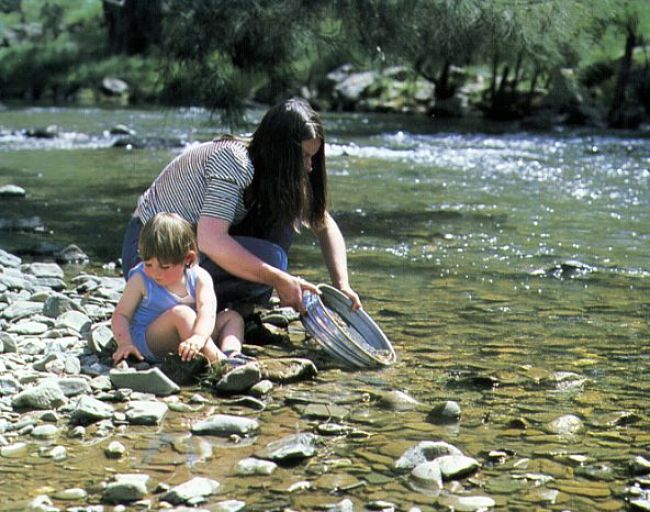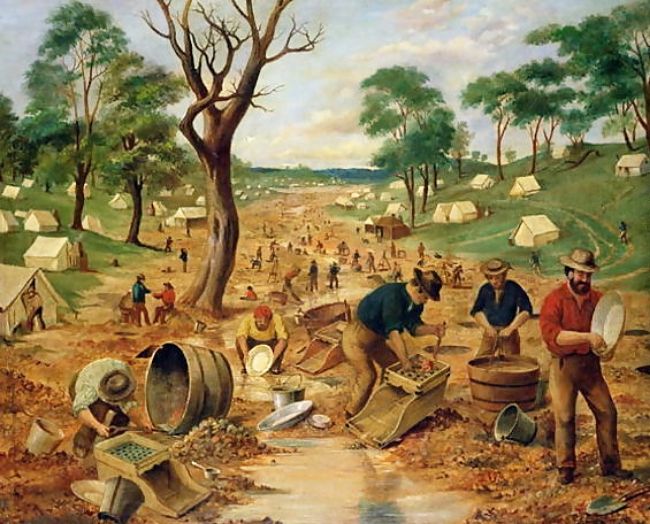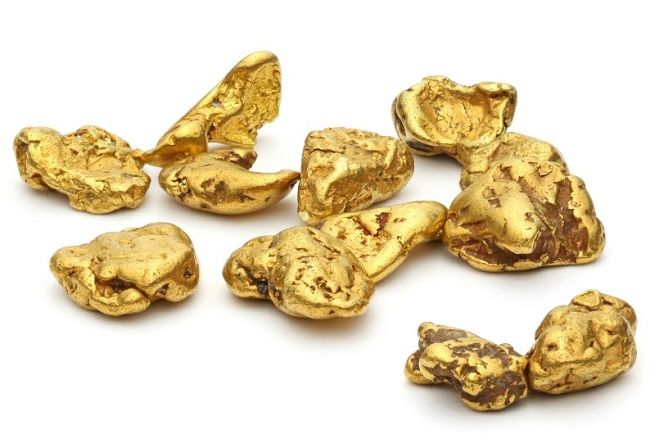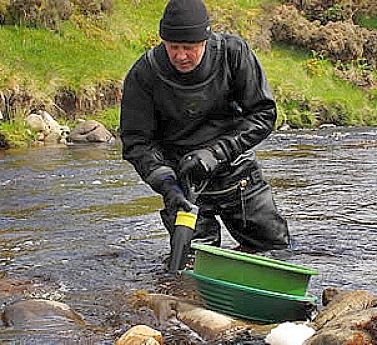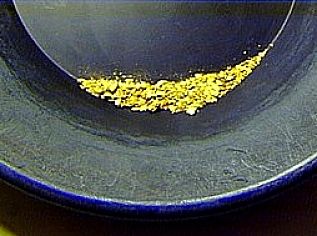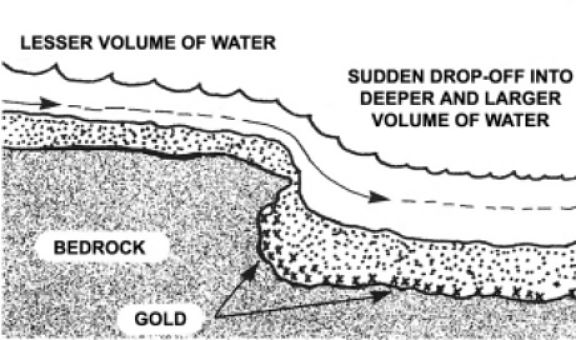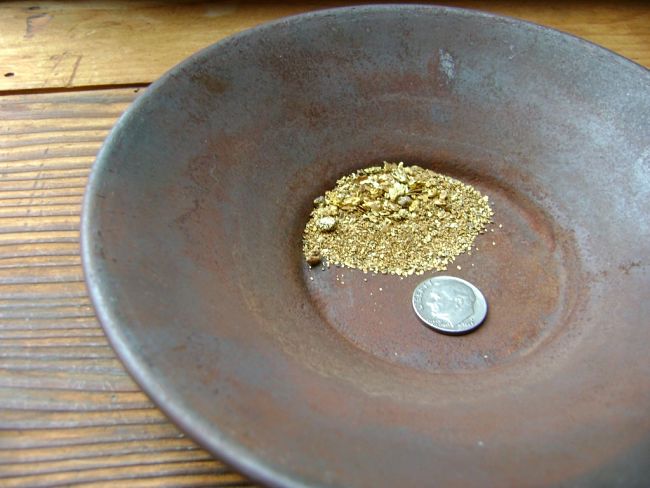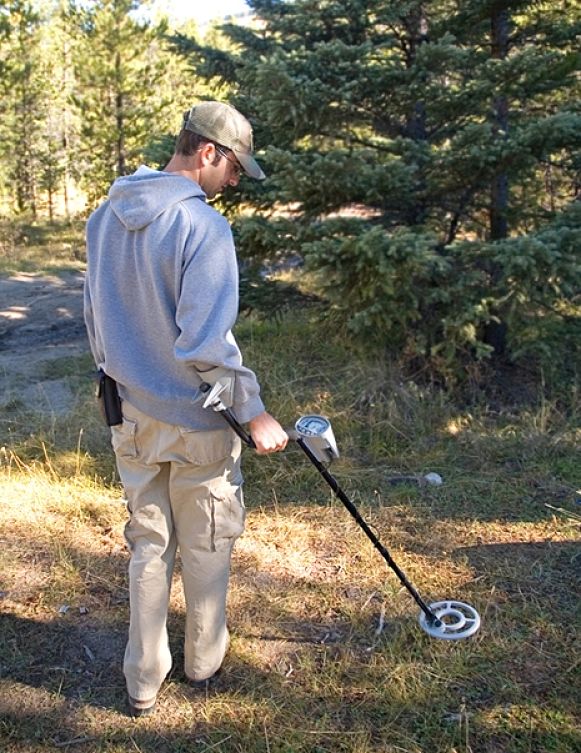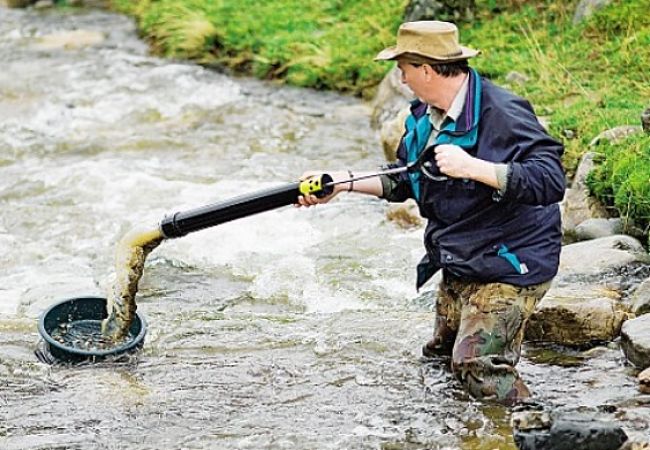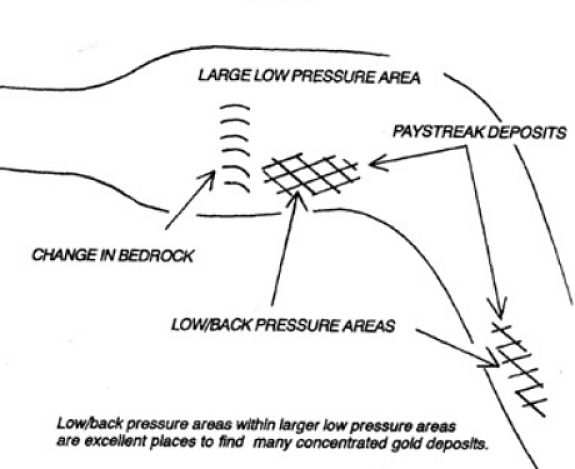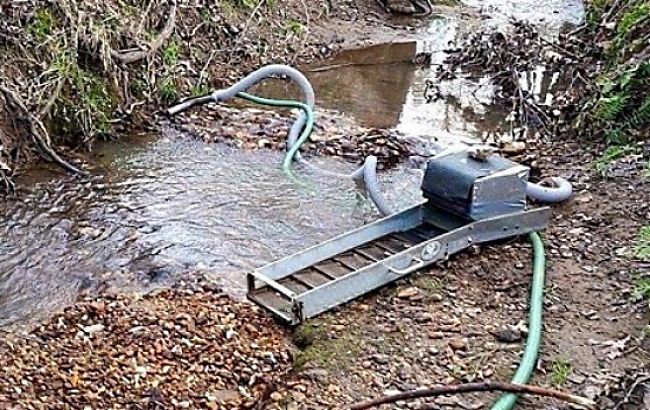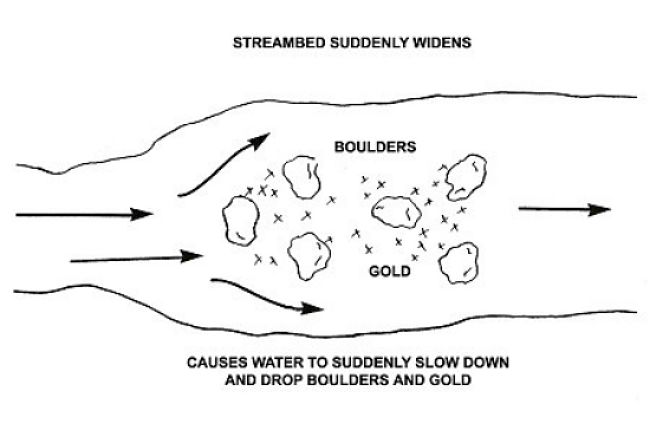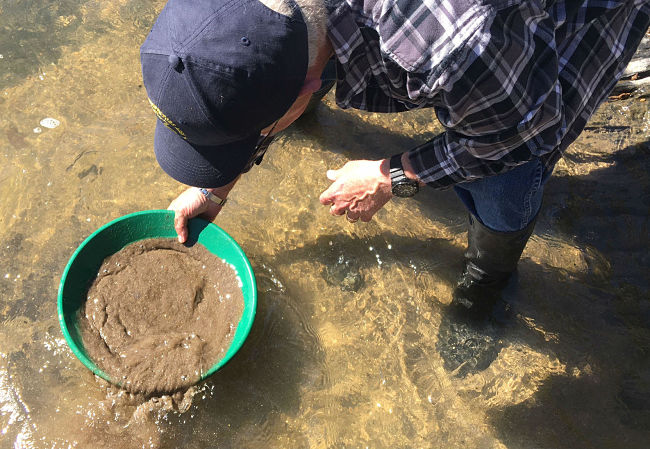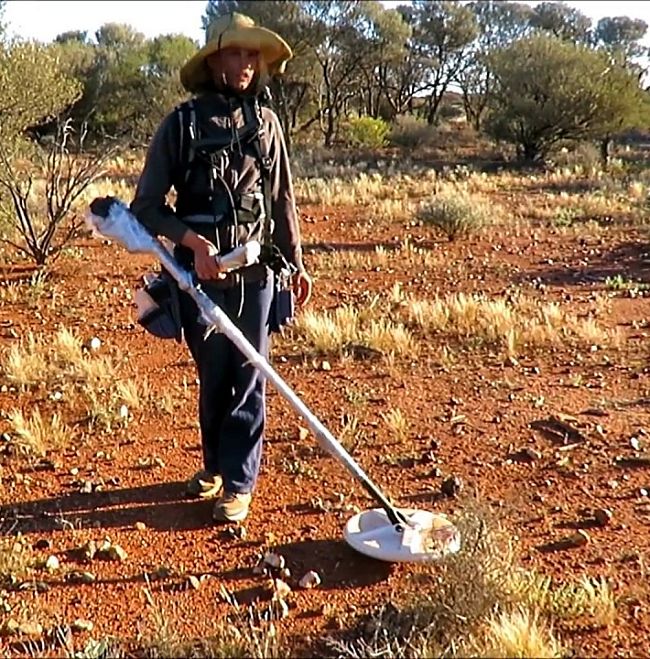How and Where to Find Gold
Times are tough. But the Gold price has reached record levels. There's Gold in them there hills (and streams) but how to you find it? The first question is where to look to find Gold. The answer is research - lots and lots of research and knowing what you are looking for. After that is hard work and luck.
This articles describes how and where to find gold.

What is Placer Gold?
Amateur prospectors focus on what is called a Placer - Gold found in alluvial deposits - deposits of sand and gravel in ancient or modern stream beds or wash outs. Placers can be occur anywhere gold is found nearby sources such as quartz lodes or other hard rock sources. The gold is freed by erosion, stream flows, geological rises and falls or through glacier action.The gold, or gold bearing pieces of rock is carried by gravity and water flows to a point where the energy drops off and the gold deposits and is concentrated in these traps such as crevices and locations where the energy level declines such as on the point bars in the stream.
Near where I live and go panning for gold is the site of location of a minor 'gold rush'. After every minor and major flood the people 'in the know' go there are try their luck panning for gold and the water flow moves the residual gold around. You can sell the gold to the local baker. Just buy some of his bread, but don't eat it because it is as hard as a rock. For many years there have been proposals to mine the gold bearing sand in the ocean offshore from the river mouth. There have been proposals to mine the deep underground source of the gold. Unfortunately that is about to happen as a new mine is to be develop on the 'mother' lode, but these is likely to be gold in the river for many years to come.
Generally the eroded gold does not move very far from the lode or reef deposit, so knowledge about the location of the source can help. Gold is often found associated with copper and black mineral sands and may remain with rock still attached. Geological events can triggers erosion and release of placer deposits. Ancient flood plain, river bench channels and river channel deposits are good examples of gold-bearing deposits formed by these events.
Remember that this is a continuous and ongoing process - if the source remains, then there will be new gold deposited over time. New gold could be washed down and deposited during the annual floods and peaks in the flow and so it may be worth reworking some areas every year or so. Look at the near-surface materials on upstream stream bars or in deep depressions and crevices in the channels.
Why Can 'Worked-Out' Areas Still Have Gold?
Just because a Gold rush deposit site has been worked over does not mean all the gold has gone. Also some of the original deposits were incredibly rich and the miners would not have been bothered with the smaller nuggets. The miners did not have modern metal detectors and they would have missed some gold.
Stream beds are most important deposits for the small operator, but the floodplain benches, gravel terraces for the modern streams and the ancient rivers are good places to look for gold. Sand beds near where streams enter other streams or lakes, at foot of steep grade areas at the boundary where streams enter into broader valleys are good places to look. The mouth of rivers where they enter the sea is another good spot. In desert areas, placers may be present along gulches arroyos or in cones or outwash fans or below steep narrow canyons for intermittent streams.
It is good to understand the phases that applied to the discovery and extraction of gold in a gold rush area. Following discovery, these areas were 'rushed' by diggers who quickly scanned the surface and dug hundreds of shallow holes and shafts trying to find the rich surface deposits, mostly focusing on nuggets. Rarely the excavations would yield gold nuggets and these successes could suggest the direction to the mother lode or source and to other areas with good prospects.
Some Australian gold fields, in Victoria, were initially so rich that the ground was strewn with large nuggets. Many of the first diggers simply dug up shovels of dirt and sieved it roughly in the shovel itself, by bouncing the material up and down. If they failed to hear the clang of gold they simply tossed the dirt aside. Occasionally even the weight of the shovel full or dirt itself was enough to suggest that a nugget was present. These methods known as 'potato diggings' were used at Kingower in Victoria. Obviously gold may have remained in the dirt cast aside. In other cases a lack for processing the grave and sand may have mean that the area was abandoned before being exhausted.
Following the first 'nuggety' rush, some miners with extra skill and better equipment stayed or moved into the area. They looked for the reefs, dug deeper shafts looking for the sources of the alluvial gold. The worked through huge sand and gravel deposits using sluices and various types of mills and shaker boxes. Others followed who reworked the mullock heaps abandoned on the field. These miners were still looking for nuggets but their better equipment meant that they could harvest the fine gold dust as well.
The Californians who joined the Australian Gold Rush were very skilled at diverting streams, building dams and building sluices. They creates water supplies to process the sand and gravel from the river bed deposits and to have water to feed their crushers and sieves that separated the quartz or slate from the gold.
The Chinese gold fossikers in Australia developed their own method for working through large deposits of rich fields. They worked away to remove all of the rock and soil above bedrock and moved it to be washed in a 'puddler'.
'Dry blowers' initially developed in Mexico, were used in the Western Australian goldfields. This equipment had a 'hand shaker' and a series of sieves. Other more modern varieties use a stream of hot air applied to a 'curtain' of falling sand and rock.
The point of this is discussion is that the gold extraction, especially many years ago was never perfect and the mullock and debris heaps and old grounds are the first place to look for gold remnants.
How to Do the Research
Doing thorough research is the key to success in finding gold. The internet makes it much easier now, but don't forget the libraries, Mines Department or whatever other authority registers leases. Local knowledge from farmers, prospecting club, historical societies and other such sources are also very useful. You also need to understand the local rules and legislation and the location of mining and prospecting leases and their status. You may be able to hunt for gold in a declared lease area if you get the owner's permission - but you need to know the regulations and meet the minimum requirements. Rules regarding access to private land is also critical and local prospecting regulations.
The first place to try looking for gold is a spot where alluvial gold has been extracted in the past. This means that you have a good chance of seeing a little glitter in your pan simply by working on the sand along the bank to start off.
So How do you Find Gold in Other Places
Step 1 is to research the internet, local bookstore, local historical society or library. Find out what you can there. The information may be fairly general but it is a good way to start. You may be able to find books and information about some of the local sites.
Step 2 is to find detailed information about the site and location you have selected to explore. The best place to go is the Mines Department that you will find in your regional or capital city. Spend time getting to know what's available and how to access it by talking to the staff. There is a wealth of information once you understand how to access it. The information you want is very specific, detailed and accurate.
The information you are looking for will include:
- The date the location was gazetted or registered as a goldfield or prospecting site.
- Locations of sites, shafts, workings and mines
- Location of slag heaps, mine workings and old equipment (very important)
- Gold Yield Information
- Type of Gold found and how it was mined (reef, alluvial, deep lead etc.)
- Current lease holders and the boundaries of the leases ( and contact details)
- Future prospects, local geology, mining plans
- Environmental issues and restrictions
- Detailed maps ( including Google Maps)
Step 3 - While you are at the Mining Department find out about the prospecting laws that apply to the prospecting area to make sure it is alright for you to go prospecting and hunting for gold in the area. In some areas there are laws that prohibit you from panning for gold unless you get a Fossicking permit, Prospecting Leases, or Miner's Right. Find out who owns the property you will visit and if there are existing leases for the area and their status.
Step 4 Find local books about the history of mining in the area, and read historic newspapers. See whether there any local cubs you can join.
Step 5 Start by finding a suitable location to learn how to do it. Choose an existing goldfield with good access - you can venture out to more remote locations when you have more experience. A good way to get stated is to contact the local caravan park or other accommodation centre. If it is a prominent mining area the caravan park owner will often hire you equipment, provide local maps and will often provide advice and training. The local will also know of someone who may act as a guide.
How to Get Started
There are basically three ways to go out prospecting
- Using a metal detector to search for nuggets
- Prospecting in streams with a gold pan or sieve of similar device ( a metal detector is also useful here as well)
- Prospecting in dry alluvial deposits and wash outs. Dry sieves can be used.
This article mostly focuses on finding gold in rivers.
You Have to Think Like a Piece of Gold to Find Gold in Rivers
The rivers and streams are the best place to look for gold as the water movement hopefully does most of the work for you, in concentrating the gold which is heavier and denser than the sand or gravel in the stream.
As material gradually washes off the slopes and into streams, it becomes sorted or layered, and gold concentrates in low flow areas, in depressions and crevices and at the base of the sediment just above the bedrock with heavy minerals such as magnetite black and heavy is almost invariably present. The gold may not be entirely separated from the parent rock such as quartz. As the gold is carried downstream, it erodes and may be released from the attached rock. The final product is gold flakes and tiny particles or gold that appears as a glint in the gold pan.
Because gold is heavier than the sand, it tends to work its way down through the travel to accumulate close to bedrock. It often works its way into cracks and crevices in the bedrock and on the bed of the stream. Gold will tend to accumulate at the foot or head of a stream bar and in the deeper parts such as the bends on a meandering streams. This is where the water current is slowed. Pockets of gold can build up behind boulders or other barriers such as logs. The best place to look is generally just above bedrock. The black sands at the base of the bed. or behind boulders are an excellent indicator of where to look as gold willoften be found there as well.
Practical Guide for Finding Gold in a River
Look carefully at the river and try to imagine you are a piece of HEAVY gold. Where would you as a piece of gold be found - in the crevices, depressions and crannies and nooks and at the base of the gravel close to the bedrock.
If you like swimming then don your mask and fins and look for gold jammed in crevices. Suction equipment can be used by a diver - bit check if it is legal in your area.
To get at the gold layer you will need to remove the gravel somehow - the method used does not matter. In Australia a good thing to use is a 'yabbie pump' - (see the image blow) to slurp out the sand and gravel and to collect the base layer. You have to go right down to the bedrock.
Yabbie Pump

Sieve off the sand and gravel, and always check for nuggets. Use your pan to find the gold in each sample. There are various websites that show you how to pan for gold.
Learning to Pan for Gold
See Gold Panning Instructions
Using Metal Detectors
See Guides for Finding Gold Nuggets using a Metal Detector
Good Luck!
